The Asiatic Wild Ass (Equus hemionus), also known as the Onager, is a distinctive member of the Equidae family, characterized by its robust and muscular build. The species displays a sandy to reddish-brown coat, which lightens during the winter months to a paler, almost whitish hue. This coloration aids in camouflage within their natural habitats. They possess a dark dorsal stripe running from the nape to the tail, which serves as a key identifying feature. Adult Asiatic Wild Asses typically weigh between 200 to 290 kilograms and stand about 1.2 to 1.5 meters at the shoulder. Their legs are strong and slender, adapted for swift and sustained running, allowing them to reach speeds of up to 70 kilometers per hour.
Habitat
The Asiatic Wild Ass is primarily adapted to arid and semi-arid environments, thriving in regions where vegetation is sparse and water sources are scarce. Historically, their range extended across a vast expanse of Asia, from the Arabian Peninsula through Iran, Afghanistan, Pakistan, and into northern India and Tibet. However, due to habitat destruction, hunting, and competition with livestock, their range has significantly diminished. Today, they inhabit desert plains, grassy steppes, and mountainous terrains where they can find adequate forage and limited human disturbance. Their diet mainly consists of grasses, leaves, and bark, which they can digest efficiently, thus requiring minimal water intake—a critical adaptation for survival in harsh environments.
Concentration in India
In India, the Asiatic Wild Ass is predominantly found in the Little Rann of Kutch in the state of Gujarat. This region serves as the last remaining stronghold for the Indian population of the species, known locally as the Khur. The Little Rann of Kutch, characterized by its saline desert plains and seasonal wetlands, provides a unique and suitable habitat for these animals. This area is part of the Indian Wild Ass Sanctuary, established in 1973 to protect the remaining population from further decline. The sanctuary spans approximately 5,000 square kilometers, encompassing a variety of landscapes, including marshes, grasslands, and scrublands, which are essential for the species' survival.
Conservation efforts within the Indian Wild Ass Sanctuary have been relatively successful, leading to a gradual increase in the population. As of recent estimates, the population of Asiatic Wild Asses in the Little Rann of Kutch numbers around 4,000 individuals. This resurgence is attributed to stringent protection measures, habitat restoration, and community engagement initiatives aimed at reducing human-wildlife conflicts.
Conservation Challenges
Despite the successes, the Asiatic Wild Ass faces ongoing threats that require continuous attention. Habitat fragmentation and degradation remain significant concerns, driven by industrial development, salt extraction activities, and the expansion of agriculture. Additionally, the encroachment of invasive plant species into their habitat reduces the availability of native forage. Climate change also poses a long-term threat to this wild animal, potentially altering the delicate balance of the desert ecosystem on which they depend.
Efforts to mitigate these threats involve a combination of habitat management, legal protection, and scientific research. Monitoring programs track population dynamics and health, while community-based conservation projects aim to foster coexistence between local human populations and wildlife.
The Asiatic Wild Ass stands as a resilient symbol of
adaptation to harsh environments. Its presence in India, particularly within
the Little Rann of Kutch, highlights the importance of dedicated conservation
efforts. Continued focus on protecting and restoring their habitats, alongside
fostering human-wildlife coexistence, remains crucial for ensuring the
long-term survival of this remarkable species.




 The Indian wild boar (Sus scrofa cristatus) is a notable
subspecies of the wild boar found predominantly in the Indian subcontinent.
Adult males typically exhibit a robust and muscular build, with their body
length ranging between 120 to 180 centimeters, and their weight fluctuating
between 90 to 130 kilograms. Females, being slightly smaller, weigh between 60
to 100 kilograms. One of the most distinctive features of the Indian wild boar
is its coarse, dark bristly coat, which often appears black or dark brown. The
underparts tend to be lighter in color.
The Indian wild boar (Sus scrofa cristatus) is a notable
subspecies of the wild boar found predominantly in the Indian subcontinent.
Adult males typically exhibit a robust and muscular build, with their body
length ranging between 120 to 180 centimeters, and their weight fluctuating
between 90 to 130 kilograms. Females, being slightly smaller, weigh between 60
to 100 kilograms. One of the most distinctive features of the Indian wild boar
is its coarse, dark bristly coat, which often appears black or dark brown. The
underparts tend to be lighter in color. 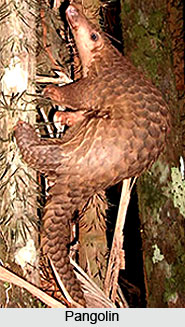
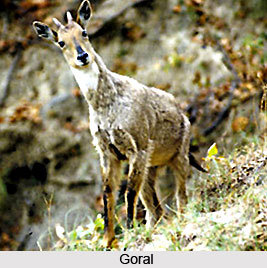
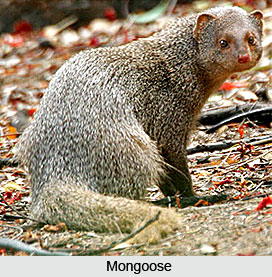 The Indian mongoose, scientifically known as Herpestes
javanicus, is a small carnivorous mammal belonging to the family Herpestidae.
It exhibits several distinct physical characteristics that aid in its
identification and survival in diverse environments. Adult Indian mongooses
typically measure between 36 to 45 centimeters in length, excluding their bushy
tails which add an additional 40 centimeters. They generally weigh between 0.6
to 1.5 kilograms.
The Indian mongoose, scientifically known as Herpestes
javanicus, is a small carnivorous mammal belonging to the family Herpestidae.
It exhibits several distinct physical characteristics that aid in its
identification and survival in diverse environments. Adult Indian mongooses
typically measure between 36 to 45 centimeters in length, excluding their bushy
tails which add an additional 40 centimeters. They generally weigh between 0.6
to 1.5 kilograms.  The Royal Bengal Tiger, scientifically known as Panthera
tigris tigris, is a prominent and majestic subspecies of tiger found primarily
in the Indian subcontinent. Renowned for its striking appearance and
significant role in the ecosystem, this apex predator is a symbol of strength
and power.
The Royal Bengal Tiger, scientifically known as Panthera
tigris tigris, is a prominent and majestic subspecies of tiger found primarily
in the Indian subcontinent. Renowned for its striking appearance and
significant role in the ecosystem, this apex predator is a symbol of strength
and power. 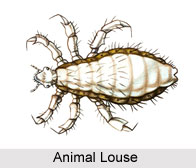
 The Indian Wild Ass (Equus hemionus khur), also known as the
Khur, is a striking member of the equid family, noted for its distinctive
physical characteristics. It stands at about 100 to 120 centimeters at the
shoulder, with a body length ranging from 200 to 250 centimeters. The weight of
an adult Indian Wild Ass can vary between 250 to 400 kilograms. The coat of the
Indian Wild Ass is typically sandy or chestnut brown, which helps it blend into
its arid habitat. In winter, the coat turns paler. A prominent feature is the
dark stripe that runs along its back from the neck to the tail. Additionally,
they possess strong and slender legs, enabling them to run at speeds of up to
70 kilometers per hour, which is crucial for evading predators and navigating
their vast habitat.
The Indian Wild Ass (Equus hemionus khur), also known as the
Khur, is a striking member of the equid family, noted for its distinctive
physical characteristics. It stands at about 100 to 120 centimeters at the
shoulder, with a body length ranging from 200 to 250 centimeters. The weight of
an adult Indian Wild Ass can vary between 250 to 400 kilograms. The coat of the
Indian Wild Ass is typically sandy or chestnut brown, which helps it blend into
its arid habitat. In winter, the coat turns paler. A prominent feature is the
dark stripe that runs along its back from the neck to the tail. Additionally,
they possess strong and slender legs, enabling them to run at speeds of up to
70 kilometers per hour, which is crucial for evading predators and navigating
their vast habitat. 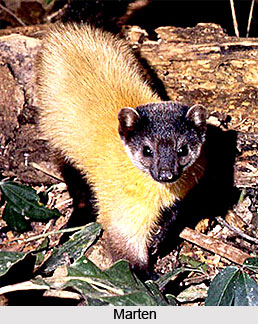 The Marten, a small to medium-sized carnivorous mammal, is
part of the Mustelidae family. These agile creatures are known for their sleek
bodies, bushy tails, and sharp claws. In India, martens are represented by two
species: the Nilgiri marten (Martes gwatkinsii) and the Yellow-throated marten
(Martes flavigula).
The Marten, a small to medium-sized carnivorous mammal, is
part of the Mustelidae family. These agile creatures are known for their sleek
bodies, bushy tails, and sharp claws. In India, martens are represented by two
species: the Nilgiri marten (Martes gwatkinsii) and the Yellow-throated marten
(Martes flavigula).  The Indian striped hyena (Hyaena hyaena) is a prominent
member of the Hyaenidae family, primarily found across the Indian subcontinent.
This species is distinguished by its unique physical features and specific
habitat preferences.
The Indian striped hyena (Hyaena hyaena) is a prominent
member of the Hyaenidae family, primarily found across the Indian subcontinent.
This species is distinguished by its unique physical features and specific
habitat preferences. 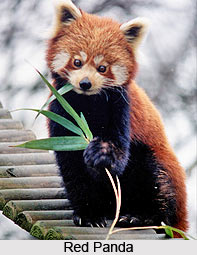 Red pandas (Ailurus fulgens) are small, arboreal mammals
native to the temperate forests of the Himalayas. Despite their name, they are
not closely related to the giant panda but are instead the only extant species
of the family Ailuridae. In India, red pandas are found in the Eastern
Himalayas, where conservation efforts are crucial for their survival.
Red pandas (Ailurus fulgens) are small, arboreal mammals
native to the temperate forests of the Himalayas. Despite their name, they are
not closely related to the giant panda but are instead the only extant species
of the family Ailuridae. In India, red pandas are found in the Eastern
Himalayas, where conservation efforts are crucial for their survival.
